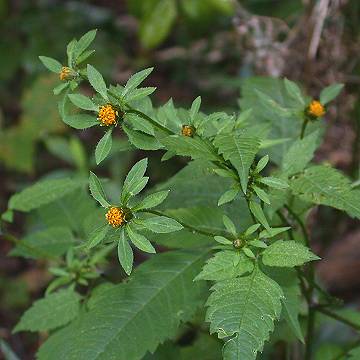

Bidens frondosa - (image 1 of 5)
Taxonomy
Family: Asteraceae
Habitat
Common on weedy ground. More natural habitats include marshy ground and vernal wet depressions in upland woods.
Associates
In marshes with Asclepias incarnata, Aster novae-angliae, Bidens cernua, Cicuta maculata, Eupatorium perfoliatum, Impatiens capensis, Leersia oryzoides, Lycopus americanus, Polygonum hydropiperoides, Scutellaria lateriflora, Sium suave, Solidago canadensis.
Distribution
Newfoundland and Nova Scotia west to WA, south to GA, LA, and CA.
Morphology
Annual to 1.2 m; glabrous or nearly so. Leaves pinnately divided; leaflets 3-5, petiolate, uncleft, most more than 3 times longer than wide. Ligules absent or shorter than the involucre; outer involucral bracts fewer than 10 and more than 5, weakly to strongly ciliate along the margins; disk corollas orange.
Notes
Flowers late June to mid October
Wetland indicator: Facultative Wetland
The lack of colorful ligules makes this species somewhat inconspicuous, except in late summer when it produced prodigious quantities of seed that stick tightly to clothing. Perhaps because of this aspect Gleason & Cronquist call this plant Devil's Beggar-ticks.
References
Gleason, Henry A.
and A. Cronquist. 1991. Manual of Vascular Plants of Northeastern United States
and Adjacent Canada. Second Ed.
The New York Botanical Garden. Bronx, NY
Swink, F. and G.
Wilhelm. 1994. Plants of the Chicago Region.
Indiana Academy of Science. The Morton Arboretum. Lisle, Illinois
|
Michael Hough © 2004 |